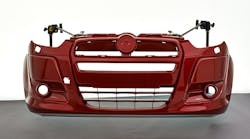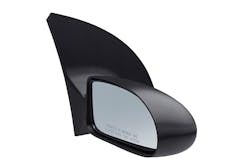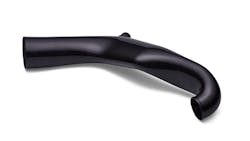This file type includes high-resolution graphics and schematics when applicable.
Scott Dunham, Vice President of Research, SmarTech Publishing
Scott Dunham has published nearly two dozen deep-dive industry analysis reports for 3D printing, and developed a multitude of leading industry forecast models. Scott has also engaged in global consulting engagements with leading stakeholders in the 3D-printing industry throughout its largest growth period, and more. Machine Design asked Scott about a recent report suggesting how 3D printing is changing the automotive industry.
Is autonomous driving affecting the adoption of 3D printing in the automotive industry?
I think the autonomous driving phenomenon may be a tertiary factor in the increased usage of 3D printing for manufacturing of automobiles. To me, autonomous driving represents a significant shift in thinking when it comes to automobile design in general, as well as radically altering the concept of personal mobility. This technology opens new doors in the world of light vehicles and has big ramifications in the design and manufacture of such cars.
The same type of significant departure from the norm would be required for a significant rise in the use of 3D-printing technologies in serial manufacturing of automobiles for the mass market. To fully exploit the benefits of 3D-printed manufacturing in automobiles, it takes a radically different approach to design and concept. This is being demonstrated somewhat by the PSA Group—a European car manufacturer—looking to integrate an entirely new design and manufacturing platform developed around 3D printing through Divergent3D.
Other players are taking a bit more cautious approach. They are simply printing some existing noncritical parts rather than injection molding them because of some cost and lead-time savings in relatively “safe” luxury and high-performance models.
What key factors will drive 3D printing in the automotive market?
This could be answered a few different ways depending on your viewpoint, because there are quite a few innovative ways that 3D printing is being applied to the automotive design and manufacturing chain for the benefit of manufacturers and suppliers. For example, the vast majority of the current deployments in the industry are around rapid prototyping for automobile design to cut down lead times on designing new models or revisions. Although with only around 15% to 20% penetration currently, we estimate a lot of room to grow in rapid prototyping.
This passenger side mirror mount was manufactured using FDM technology in ASA material. (Courtesy of Stratasys Direct Manufacturing)
What would drive further growth in this area of current deployments would be increasing the access to printers, which we are seeing, through lower-cost offerings, and a larger, more flexible approach to material processing. The advances in materials used in 3D printing allow for printing a closer match to the production materials and increased throughput of various print technologies, etc. All of this appears to be well underway.
Then we have applications in additive tooling, which could also be significantly impactful in a similar way to prototyping. It can drastically reduce lead times and costs for both prototype parts and potential production parts. Printed tools represent, in my opinion, the biggest area of low-hanging fruit for moving adoption of 3D printing forward in the industry. Producing hard tools through metal powder-bed fusion is rapidly growing. This is largely thanks to an increased awareness of the benefits and a growing competency with this technology among tool shops that want to differentiate themselves from the market by providing a high-value service.
Finally, what will ultimately drive the use of 3D printing on the production side will involve efforts in mass reduction. Of course, mass-reduction initiatives could also be considered a driver for printed tools and prototypes. To fully take advantage of additive's ability to reduce the weight of automobiles, you would probably want to print lots of prototypes and test parts first. This could involve the use of printed tools for added synergy.
Ultimately, I would say that efforts in mass reduction will be the biggest driver, but we might not see them materialize outright for several more years. Right now, an OEM or a supplier undertaking the use of 3D printing to produce a relatively nondescript wiring bracket as a production part is a huge step forward for the industry. These efforts will breed a competency and confidence in design for additive processes that could enable much greater mass reduction.
3D printing is able to print complex molds with dissolvable material. Once the mold is generated and the composite cured, the mold can be dissolved, leaving a finished composite part. (Courtesy of Stratasys Direct Manufacturing)
What materials are going to be popular?
Efforts to print aluminum alloys are being driven to a high degree by the auto industry. However, traditional aluminum alloys are still a challenge for the metal powder-bed processes today. Much of the aluminum printing in alloys is not familiar to the auto industry today, which somewhat limits their popularity. Ultimately, the powder-bed fusion processes for printing of metal will see a lot of demand from the auto industry. In addition, the aluminum alloys and stainless steels for printing of functional prototypes will happen first, along with hard tools, and then perhaps production parts in the next five years or so.
Composites using carbon and glass fiber reinforcement are also going to be quite significant for the auto industry in 3D printing. This is a multi-faceted challenge, though. The industry itself isn't using a ton of composites just yet, but the demand to develop better composite processing solutions for high-volume auto manufacturing is definitely there.
High volume isn't typically something that additive has done well in the past, but there's some interesting things being worked on now in that regard, such as the large format, near-net capabilities of thermoplastic composite extrusion. The auto industry in general can definitely be credited with helping push the 3D-printing industry toward composite solutions at a faster rate over the last five years.
What types of 3D processes are being adopted?
It's really across the board. There's a place for most every additive process somewhere in the auto design and manufacturing chain. We see quite a bit of growth in the powder-bed fusion segment, both in polymers and in metals. Currently, the only known production automobile parts being printed for use in cars, outside of racing segments, are created using the thermoplastic-composite capabilities of selective laser sintering. We also expect material extrusion, such as FDM from Stratasys, to account for a significant amount of share in the auto industry. Extrusion processes are flexible in their ability to process thermoplastics, and are now being combined with reinforcing materials in the search for composite solutions, especially with carbon fiber. Those two will most likely be the biggest.
Building in layers may not be pleasing to the eye. However, there are post-processes and paint to smooth parts for an astatically attractive finish. This front end of a vehicle was printed in ABS plastic. (Courtesy of Stratasys Direct Manufacturing)
Photopolymerization technologies—such as DLP, stereolithography, or similar approaches like that of Carbon—have their own place, especially in prototypes and tools. The envelope for these technologies is being pushed through continued resin development.
Resins, of course, can be tailored in chemistry to emulate a huge range of properties. However, the catch right now is that their UV-curing principle historically means that their properties change—mostly degrade—over time and exposure to more UV light. This has mostly prevented them from being considered a manufacturing solution. Although, I don't think it's out of the realm of possibility that this could change through chemistry.
Firms like Carbon certainly are talking as though they have an eye of production parts, but for now it's not in the same league as powder-bed fusion or extrusion in terms of production parts. Still, these technologies might be the ultimate prototyping tools for the industry thanks to simulated thermoplastics, adjustable material properties, or multi-material printing, like in material jetting or Polyjet, along with the great aesthetics.
What standards are associated with 3D printing and the automotive industry?
This is an interesting issue, because there still really aren’t any standards for manufacturing in the auto industry with 3D printing. Like all other industries chasing additive production, the standards have to be developed, tested, and agreed upon. One of the major reasons that auto manufacturers don't just use the functioning parts they print as prototypes in production vehicles is because all of the standards are based around molded parts and materials used in molding.






